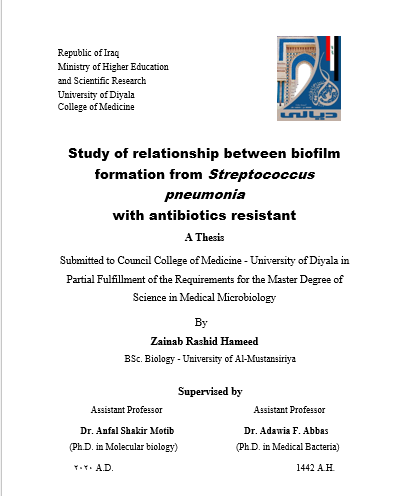Summary
Streptococcus pneumoniae is one of the major general causes of important diseases world-wide such as pneumonia and meningitis with a high morbidity and mortality in adults especially in elderly people. This bacterium plays an important role in pneumonia due to its seriousness and the lack of successful solutions to treat it. Pneumococcal biofilms are essential for colonization and persistence, and it is important to continue to investigate the environmental conditions which affect their formation. Biofilm’s importance depends on the reduced sensitivity of this bacterium to antibacterial agents and their capacity to withstand the immune defense mechanisms of the host. This study came to find out the adaptability of biofilm formation in S. pneumoniae that causes pneumonia in Diyala city and diagnose them with PCR method by using 16SrRNA for pneumococcal detection in addition to the roads bacteriology culture test.
In this study, 192 sputum samples were collected from Bacteriology Unit of Baquba teaching hospital, Chest Diseases Consultation Clinic and Al-Khalis General Hospital from October 2019 to January 2020. It appeared that 122 (64%) samples showed no growth while 70 (36%) showed positive growth. Streptococcus pneumoniae isolates were obtained from 32 isolates and diagnosed using culture, biochemical tests and microscopic assays as well as using molecular methods including, detection 16SrRNA.
The antibiotic susceptibility test was applied to all pneumococcal isolates by using 14 antibiotics. The results showed that all the isolates were resistant to Tobramycin 100%. The variation in resistance among isolates to several antibiotics including Gentamycin, Erythromycin, and Azithromycin was a percentage of 87.5%. Tetracycline showed 75.5% resistance, Chloramphenicol 62.5%, Streptomycin 50%. The Clindamycin showed 37.55% resistance. Imipenem reflected 25%, Rifampin 50% and Cefotaxim, Penicillin, Amoxicillin and Vancomycin showed 12.5% resistance.
In the molecular method, the genomic DNA was extracted from 32 samples of broth culture (BHI) and used directly for PCR to detect Streptococcus pneumoniae. The results of this study showed of (16SrRNA gene) by PCR, which was positive in 32 (100%). In addition, the PCR product of the samples were sent for sequencing to identify the Streptococcus pneumoniae strains. The results appeared that the strains of S. pneumoniae that cause pneumonia in Diyala city are K10 (12) and D39 (20) strains. Using NCBI program to analyze genetic sequences and the identity was 100% for all isolates
The prevalence of pneumonia infection in this study was more in males than in females as the percentage were (53.1%) and (46.9%), respectively, and the incidence of S. pneumoniae in smoking patients was (53.1%), while it was (46.9%) among non-smokers.
Biofilm formation assay was measured biofilm by using microtiter plate biofilm assay in three different media and the biofilm formation was measured at the four bacterial growth phases to show the adaptability of biofilm formation in different culture media. Data of the current study showed that the ability of pneumococcal to form biofilm was better when using a poor medium such as nutrient broth, and the highest value was at the stationary phase.





